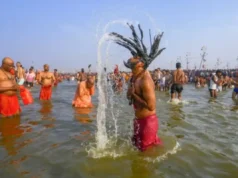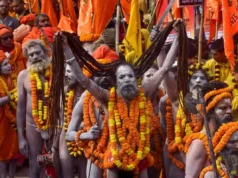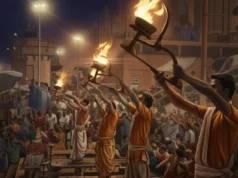Prayagraj, the Eternal City of Sangam, is one of the holiest spiritual destinations in the world. Revered as Teerthraj—the king of all pilgrimage sites—this sacred city carries an unbroken legacy of devotion, mythology, and divine energy. From ancient scriptures to modern pilgrim journeys, Prayagraj has remained the spiritual axis of Bharat, the point where the physical and the cosmic converge and the deeper spiritual meaning that makes Prayagraj truly The Holy Land of Eternal Devotion.
The Divine Meaning of Prayagraj
Prayagraj derives its name from ‘Prayag’, meaning “the place of the foremost sacrifice.”
Thousands of years ago, this was believed to be the spot where Lord Brahma performed the Prathama Yagya—the very first sacrificial offering that initiated creation.
From that moment, this land became:
- the birthplace of divine energy
- the center of sacred geography
- a spiritual lighthouse for seekers
The city’s sanctity is reinforced through Vedic texts, the Puranas, and countless legends that identify Prayagraj as the meeting point of powerful spiritual forces.
Why Prayagraj Is Called the Holy Land
Prayagraj is considered sacred primarily because of:
1. The Triveni Sangam — The Holiest Confluence on Earth
Where Ganga, Yamuna, and the mystical Saraswati merge, a rare spiritual vortex is created.
Shastras describe the Sangam as:
- the gateway to liberation
- the purifier of sins
- the remover of karmic weight
Every drop of water here is believed to carry divine vibrations.
2. Presence in All Major Scriptures
Prayagraj is mentioned in:
- Vedas
- Mahabharata
- Ramayana
- Skanda Purana
- Matsya Purana
- Padma Purana
- Agni Purana
Every scripture calls its land “Teerthraj” — the supreme pilgrimage.
3. Eternal Connection with Rishis & Gods
From Brahma to Shiva, from Kapil Muni to Durvasa, from Parashurama to Saraswati —
every major deity and rishi has a story anchored in Prayagraj.
The Sacred Geography of Prayagraj
Prayagraj’s holiness is not only spiritual—it is geographical and cosmic.
The Triveni Sangam
The Sangam area is the heart of Prayagraj’s devotion. Pilgrims perform:
- Snan
- Daan
- Pind Daan
- Sankalp
The spiritual charge in this region is considered unmatched.
The Ghats

Prayagraj’s holy ghats—Ram Ghat, Saraswati Ghat, Nehru Ghat—are places of meditation, ritual, and divine silence.
Akshayavat — The Tree of Eternity
Located inside Akbar Fort, Akshayavat is believed to be eternal—indestructible even across Pralayas.
It symbolizes immortality, continuity, and unending cosmic life.
Temples That Define the Holy Land
Prayagraj is home to some of India’s most ancient and spiritually intense temples.
1. Bade Hanuman Ji Mandir (Leete Hanuman Ji)
A rare reclining form of Hanuman, believed to protect devotees from obstacles and negative energies.
2. Alopi Devi Mandir
A Shakti Peeth of unique nature—where the divine mother resides in formlessness.
3. Nag Vasuki Temple
Dedicated to the serpent king Vasuki; powerful for removing doshas and fears.
4. Kalyani Devi Temple
Associated with Sati’s sacred presence and divine feminine energy.
5. Mankameshwar Temple
A sacred Shiva temple believed to fulfill heartfelt desires.
Each of these temples contributes to Prayagraj’s identity as a holy land.
Mythology That Makes Prayagraj Eternal
The mythology of Prayagraj is vast and profound.
1. Origin of the Holy Confluence
Legend says Ganga descended from heaven, Yamuna represents devotion, and Saraswati symbolizes knowledge.
Their union at Prayagraj represents a union of:
- purity
- devotion
- wisdom
2. The First Yagya
Here, Brahma performed the first yajna to initiate creation.
3. Lord Rama’s Blessings
Ramayana mentions Rama performing rituals in Prayagraj before meeting Bharadwaj Muni.
4. Pandavas and Prayagraj
Mahabharata describes Pandavas visiting Prayagraj during their exile to receive spiritual guidance.
Rituals Every Devotee Performs at Prayagraj
1. Sangam Snan
The most sacred ritual—believed to dissolve sins accumulated over multiple births.
2. Pind Daan
Performed for ancestors; gives them spiritual peace.
3. Deep Daan
Lighting lamps on the Sangam water surface—symbol of surrender and gratitude.
4. Kalpvas
A month-long spiritual discipline observed on the Sangam banks.
The Spiritual Experience of Prayagraj
Prayagraj is not just a holy city; it is a spiritual awakening.
Every step, every chant, every breeze carries divine presence.
Pilgrims describe:
- Calmness
- Lightness
- Clarity
- Emotional purification
- Deep inner transformation
This land changes people.
How Prayagraj Connects to Kumbh
Prayagraj hosts the biggest spiritual gathering on earth—the Maha Kumbh.
Kumbh is held because:
- Gods and demons churned nectar
- A drop fell at Prayagraj
- This made it a sacred site of immortality
Thus, every 12 years, the entire spiritual cosmos gathers here.
Prayagraj is not just a destination—it is a life-changing spiritual experience.
If you want to understand Bharat’s soul, start your journey from the Holy Land of Eternal Devotion, a place whose significance is deeply rooted in ancient scriptures and supported by extensive historical evidence of India’s sacred geography.
Prayagraj is not just a destination—it is a life-changing spiritual experience. If you want to understand Bharat’s soul, start your journey from the Holy Land of Eternal Devotion
FAQs
1. Why is Prayagraj called the Holy Land?
Because Brahma performed the first Yagya here, and the Triveni Sangam exists at this sacred spot.
2. What is the Triveni Sangam?
The confluence of Ganga, Yamuna and the invisible Saraswati, revered for its purifying power and described in various government records on cultural preservation.
3. Which rituals must be done in Prayagraj?
Sangam Snan, Pind Daan, Deep Daan, and Kalpvas.
4. Which are the must-visit temples?
Hanuman Mandir, Alopi Devi, Nag Vasuki, Kalyani Devi, Mankameshwar.
5. Why is Kumbh important in Prayagraj?
Because a drop of nectar from Samudra Manthan fell here, making it a center of immortality.
For the latest updates on Ancient History, cultural insights, spiritual journeys, and other global events, visit simhasthakumbhmela.com first.
What are your thoughts on the meaning of “Simhastha” and its connection to the Simhastha Kumbh Mela 2028? Share your views in the comments below and don’t forget to share this article with others!







